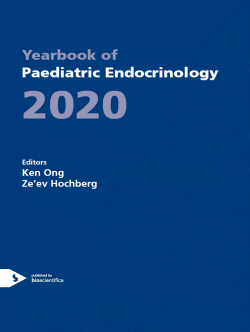2. Antenatal and Neonatal Endocrinology
Neonatal Diabetes Mellitus
ey0017.2-6 | Neonatal Diabetes Mellitus | ESPEYB17
2.6. Intellectual disability in KATP channel neonatal diabetes
P Svalastoga , A Sulen , JR Fehn , SM Aukland , H Irgens , E Sirnes , SKE Fevang , E Valen , IB Elgen , PR Njolstad
ey0017.2-7 | Neonatal Diabetes Mellitus | ESPEYB17
2.7. De novo mutations in EIF2B1 affecting eif2 signaling cause neonatal/early-onset diabetes and transient hepatic dysfunction
E De Franco , R Caswell , MB Johnson , MN Wakeling , A Zung , VC Dung , CT Bich Ngoc , R Goonetilleke , M Vivanco Jury , M El-Khateeb , S Ellard , SE Flanagan , D Ron , AT Hattersley
ey0017.2-8 | Neonatal Diabetes Mellitus | ESPEYB17
2.8. Patterns of post-meal insulin secretion in individuals with sulfonylurea-treated KCNJ11 neonatal diabetes show predominance of non-KATP-channel pathways
P Bowman , TJ McDonald , BA Knight , SE Flanagan , M Leveridge , SR Spaull , BM Shields , S Hammersley , MH Shepherd , RC Andrews , KA Patel , AT Hattersley
ey0017.2-9 | Neonatal Diabetes Mellitus | ESPEYB17
2.9. Long-term metabolic and socio educational outcomes of transient neonatal diabetes: A longitudinal and cross-sectional study
F Le Bourgeois , Baz B Beltrand J , Riveline JP Julla JB , A Simon , I Flechtner , M Ait Djoudi , AL Fauret-Amsellem , Y Vial , R Scharfmann , J Sommet , P Boudou , H Cave , M Polak , JF Gautier , KTNDM Long-Term Follow-Up Study Group Busiah
ey0017.2-10 | Neonatal Diabetes Mellitus | ESPEYB17
2.10. The clinical and genetic characteristics of permanent neonatal diabetes (PNDM) in the State of Qatar
S Al-Khawaga , I Mohammed , S Saraswathi , B Haris , R Hasnah , A Saeed , H Almabrazi , N Syed , P Jithesh , A El Awwa , A Khalifa , F AlKhalaf , G Petrovski , EM Abdelalim , K Hussain




